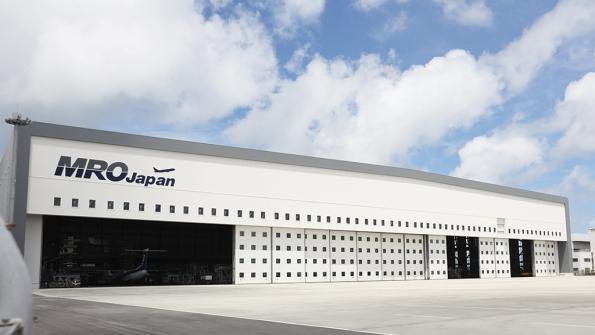
Japan has seen a shift in maintenance strategies that can be attributed both to pandemic-related circumstances and to voluntary business choices. Major Japanese carriers are pulling MRO back from China and doing more maintenance in-house. While Japan’s international flights are still down to 30% of pre-pandemic levels, domestic flying has recovered to 90% of normal operations, according to AirNav RadarBox. That domestic recovery has helped keep Japanese MRO going.
However, none of these adjustments has been easy or painless for the island nation.
Okinawa-based MRO Japan noticed the impact of the pandemic immediately. “Customer airlines quickly decided to minimize their maintenance costs to survive the pandemic,” says Takashi Shimamura, business development and marketing vice president. Line maintenance for foreign airlines, just beginning in 2020, was totally cut by suspension of international flights to Okinawa’s Naha Airport.
The pandemic also affected MRO Japan’s efforts to expand business. It had planned to obtain EASA Part 145 approval in 2020, but was disappointed, as EASA inspectors were not able to travel to Japan.
As the pandemic continued, MRO Japan found business inside Japan itself. Short-term, it received more heavy maintenance orders from Japanese airlines that faced difficulties in obtaining maintenance in China due to travel restrictions. Now, some Japanese airlines are considering working with MRO Japan for middle- or longer terms because they recognize country risks in China following the pandemic. Shimamura calls this “a huge opportunity for [MRO Japan].”
Expansion is still tough at present as carriers are still cutting costs. MRO Japan is thus struggling for growth by exploring Japan’s domestic market and cultivating new demands, such as lease-return maintenance. It will continue to expand heavy maintenance as this is its “pillar of business,” Shimamura says. This pillar rests mostly on narrowbodies, not widebodies.
Shimamura says MRO Japan has done well enough with its turn to domestic markets that it actually hired more mechanics during the pandemic. This increase had been planned since the company’s founding in 2015 to enlarge production capabilities.
One current challenge is parts. “The purchase of expendable and consumable materials is getting difficult from the planning viewpoint,” says Takuma Otsuka, MRO Japan’s manager of spare-part planning. The situation was not difficult when the pandemic started, as most suppliers still had regular stock levels, but this year MRO Japan began to sense shortages as OEMs cut production and stocks to avoid financial losses.
Otsuka says aircraft must still be maintained even if they are grounded because of insufficient revenue. He worries that the part difficulties will worsen next year as airlines recover, but stocks do not recover as fast. Suppliers may even shift to more conservative stocking strategies to avoid extra costs.
Otsuka says consumable materials are the hardest to obtain in a timely fashion for ideal purchasing. “We recently had many experiences with a major distributor’s stock running out, and we were not able to buy necessary materials from our usual suppliers,” he says. In the worst case, it could take a few months until these stocks become available.

MRO Japan’s co-investor All Nippon Airways (ANA) has decided to insource much previously outsourced maintenance “to cut redundant costs,” a spokesperson says. After a sharp drop in flights from March-June 2020, passenger demand has been gradually recovering. Scheduled tasks and the shift to in-house MRO has kept the pandemic’s impact on maintenance minimal. The spokesperson says all ANA jobs, including mechanics, were protected during the pandemic.
However, the carrier is retiring some larger aircraft to operate more efficiently and has already been using more small and mid-sized planes.
Another MRO Japan backer, Mitsubishi Heavy Industries, has a subsidiary—MHI Aero Engines (MHIAEL)—that maintains engines, including IAE V2500s; Rolls-Royce Trent 1000s, Trent XWBs and 7000s; and Pratt & Whitney PW4000s, PW1200Gs and PW1100G-JMs. A spokesperson says MHIAEL has so far been able to manage its way through the pandemic with minimal effects on its engine maintenance business. He now expects recovery in both engine overhauls and engine component repairs, especially for the PW1100G-JM—the geared turbofan that powers the Airbus A320neo.
MHIAEL retained all its staff during the pandemic, but it is experiencing logistical challenges in obtaining engine parts. Furthermore, “Travel restrictions may cause certain delays in obtaining airworthiness approvals and customer visits,” the spokesperson adds.
Japan Airlines (JAL) says the pandemic caused two major maintenance changes. First, more storage maintenance must be done on grounded aircraft. There is also more green-time management, so the airline must extend and control the timing of heavy maintenance and engine overhauls to save maintenance costs, coordinating this task with MROs.
Another change has increased maintenance work. Due to restrictions on sending airline inspectors to MROs in foreign countries—and also to cut maintenance costs—JAL has to do most heavy maintenance in-house. That has prompted busier JAL shops.
JAL is essentially an international airline, and since restrictions on international air travel remain, JAL managers are seeing no significant sign of further passenger-traffic recovery. But the airline is preparing human resources, spare parts and other resources for the recovery in maintenance. The carrier has retained all of its aircraft maintenance staff.
JAL managers say there has been no hold-up in cargo shipments due to reduced airfreight capacity. Thus, there have been no business interruptions at part suppliers or repair contractors due to the pandemic. However, says a spokesperson, “if flights are reinstated at the same time around the world, there may be a temporary shortage of parts.”
To save future maintenance costs, JAL wants to negotiate flight-hour maintenance contracts, which will have minimum flight-hour payments. These negotiations are another potential challenge.





